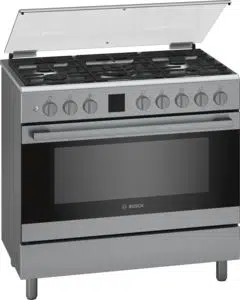Loading ...
Loading ...
Loading ...

Cleaning en
21
Surfaces in the cooking compartment
The back wall and side parts in the cooking
compartment are self-cleaning. You can tell this from
the rough surface.
The cooking compartment floor and ceiling are
enamelled and have smooth surfaces.
Cleaning enamel surfaces
Clean the smooth enamel surfaces with a dish cloth
and hot soapy water or a vinegar solution. Then dry
them with a soft cloth.
Soften baked-on food remnants with a damp cloth and
soapy water. Use stainless steel wire wool or oven
cleaner to remove stubborn dirt.
Caution!
Never use oven cleaner in the cooking compartment
when it is still warm. This may damage the enamel.
Remove all food remnants from the cooking
compartment and the appliance door before you next
heat up the appliance.
Leave the cooking compartment open to dry after
cleaning it.
Note: Food residues can cause white deposits to form.
These are harmless and do not affect how the
appliance works. You can remove these residues using
lemon juice if required.
Cleaning self-cleaning surfaces
The self-cleaning surfaces are coated with a porous,
matte ceramic layer. While the appliance is in operation,
this layer sucks the splashes from baking and roasting
on and breaks it down.
If the self-cleaning surfaces no longer clean themselves
sufficiently and dark patches appear, they can be
cleaned by running a program specifically to heat them
up.
Setting
Remove the accessories, ovenware and rails from the
cooking compartment. Thoroughly clean the smooth
enamel surfaces in the cooking compartment, the
inside of the appliance door and the glass cover on the
interior lighting.
1. Set the oven gas burner to the maximum
temperature.
2. Start the program and leave it to run for at least 20–
30 minutes.
When the cooking compartment has cooled down,
remove the brown or white residue with water and a soft
sponge.
Caution!
Do not use oven cleaner on the self-cleaning surfaces.
This will damage the surfaces. If oven cleaner does get
onto these surfaces, clean them immediately using
water and a sponge cloth. Do not rub the surface and
do not use abrasive cleaning aids.
Detaching and refitting the rails
The rails can be removed for cleaning. The oven must
have cooled down.
Unhooking the rails
1. Hold the bottom of the rail and pull it towards you a
little. Pull the extension pins at the bottom of the rail
out of the fastening openings (figure A).
2. Then pull the rail upwards and remove it (figure B).
Clean the rails with washing-up liquid and a sponge.
Use a brush to remove stubborn dirt deposits.
Hooking in the rails
1. Place the two hooks at the top of the rail into the
upper holes.
2. Both hooks must be inserted fully into the upper
holes. Now move the rail down slowly and carefully
and hook it into the lower holes.
3. Hook both rails into the side walls of the oven.
Keeping the appliance clean
Always keep the appliance clean and remove dirt
immediately so that stubborn deposits of dirt do not
build up.
:Warning – Risk of fire!
Loose food remnants, fat and meat juices may catch
fire. Before using the appliance, remove the worst of the
food remnants from the cooking compartment, heating
elements and accessories.
Tips
■ Clean the cooking compartment after each use. This
will ensure that dirt cannot be baked on.
■ Always remove flecks of limescale, grease, starch
and albumin (e.g. egg white) immediately.
■ Use the universal pan for baking very moist cakes.
■ Use suitable ovenware for roasting, e.g. a roasting
dish.
%
$
Loading ...
Loading ...
Loading ...
